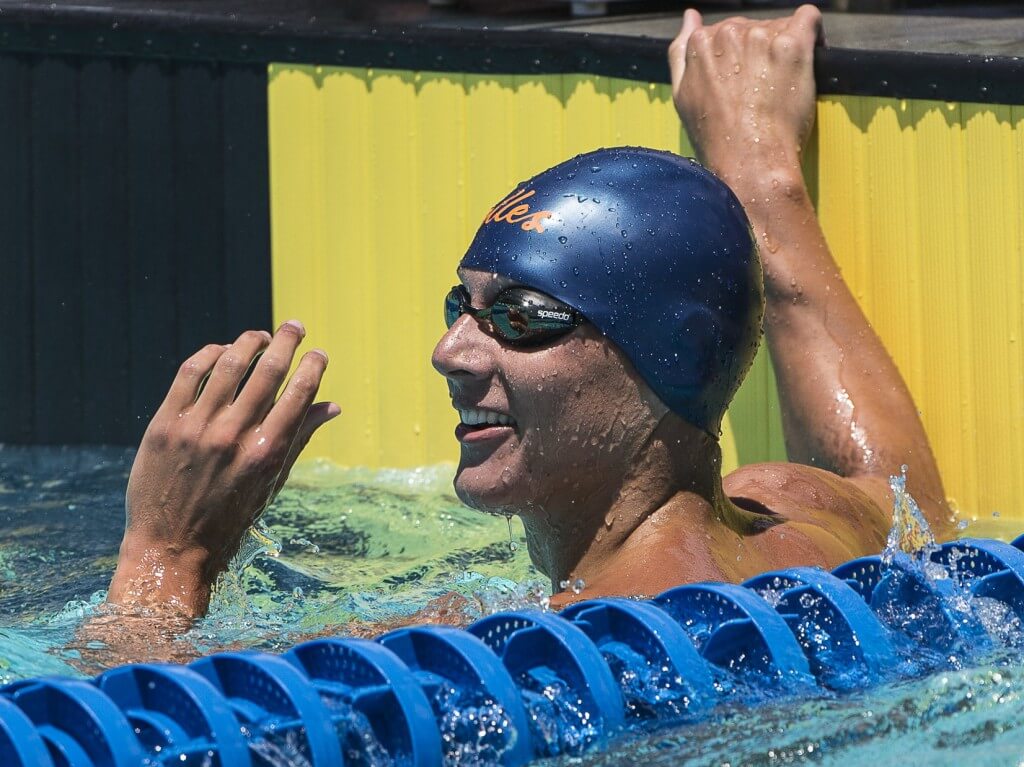Caeleb Dressel Downs David Nolan’s 17-18 U.S. National Age Group Record in 100 Free

AUBURN – While the team titles are pretty much secure in the hands of the Georgia women and Florida men, there’s plenty of individual accomplishments to be had at the SEC Championships. Florida’s Caeleb Dressel lowered David Nolan’s 17-18 U.S. National Age Group record in the 100-yard free this morning.
Women’s Meet
Georgia’s Hali Flickinger scorched prelims of the women’s 200-yard back with a 1:51.74 to clear the NCAA A cut in the event. Meanwhile, Kentucky’s Danielle Galyer just missed the A cut with a second-place 1:52.59.
Texas A&M’s Lisa Bratton and Arkansas’ Anna Mayfield also neared the A cut of 1:52.52 by tying for third with 1:52.98s.
Florida’s Natalie Hinds lowered her school record in the women’s 100-yard freestyle to clear the NCAA A cut in the event.
Hinds threw down a 47.37 for the record, finishing well ahead of the pack in prelims.
Tennessee’s Harper Bruens (48.26) and Georgia’s Chantal van Landeghem (48.27) went 2-3.
Georgia’s going to have a monster 400 free relay tonight if 100 free qualifying is any indication. Madeline Locus qualified fourth in 48.367, while Olivia Smoliga finished ninth in 48.89.
Tennessee’s Molly Hannis (2:08.36) and Texas A&M’s Ashley McGregor (2:08.89) snagged the top two times in the morning in the women’s 200-yard breast. They have a bit of time to drop to clear the NCAA A cut of 2:07.70.
Auburn’s Annie Lazor (2:09.08) and Alabama’s 100 breast winner Kaylin Burchell (2:09.16) qualified third and fourth.
Men’s Meet
Tennessee’s Sean Lehane (1:40.55) and Missouri’s Carter Griffin (1:40.55) didn’t waste any time getting their NCAA A cuts in the men’s 200-yard back this week. The two raced their way under the cuts to stand 1-2 heading into finals.
Auburn’s Joe Patching snared third in 1:40.94, right off the NCAA A cut, while Alabama went two-up with Connor Oslin (1:41.57) and Christopher Reid (1:41.85) taking fourth and fifth.
Florida’s Caeleb Dressel led 50-yard free qualifying with a 42.31, split 20.19, 22.12, for the 17-18 U.S. National Age Group Record.
That performance undercut David Nolan’s 2011 record of 42.34 and gives Dressel both the 50 free and 100 free NAGs for 17-18 year olds.
A fast prelims swims by @CaelebDressel in the 100y Fr to break the NAG 17-18 record. A look at the All-Time Top 10: pic.twitter.com/8uFWNYidkm
— USA Swimming News (@USASwimmingNews) February 21, 2015
Auburn had a huge 100 free with Kyle Darmody leading four Tigers into the A final with a third-place 42.89.
Georgia’s Nic Fink vaulted to fifth all time in the men’s 200-yard breaststroke event as he scorched prelims with a 1:51.58. That swim lowered the SEC meet record of 1:51.59 set by Anton McKee last year.
All Time Men’s 200 Breast
[table “” not found /]McKee will be looking to reclaim the record tonight, however, as he’s ranked second with a 1:53.53. Florida’s Matt Elliott (1:54.04) and Eduardo Solaeche-Gomez (1:54.36) went 3-4.
Platform diving and the 1650-yard freestyle events are all that’s left before finals tonight.




Some of us non-americans are pretty uneducated about the NCAA system. Can someone provide a quick explanation of A and B cuts? I assume you need an A cut to appear at NCAA national champs, but is that the case? If you earn one A cut, can you swim other events? Thanks in advance.
Hi AvantSwim,
Here’s a full breakdown if you want to be able to project down to the final person who gets in under the athlete cap per meet http://www.swimmingworldmagazine.com/news/ncaa-swimming-and-diving-rules-proposal-survey-provides-look-at-potential-rules-changes/
But, long story short, if you swim an A cut, you have the ability to swim that event at NCAAs as well as whatever other A and B cuts you have. You cannot swim something you do not have a cut in. You are also subject to event limitations, unlike Olympic qualifying where you can swim in as many events as you want.
Additionally, when a team gets an A cut in a relay, it means the team can swim that relay at NCAAs as long as they qualifying someone individually first.
As for B cuts, those are just provisional selections. Once the NCAA puts in all the automatic A cuts into their respective events, the NCAA then fills out the rest of the field with swimmers who had B cuts.
Same rule applies though as A cuts. Once you make it into the meet, you can swim whatever other B cuts you have up to the event limitation.
All the NCAA really cares about is keeping the athlete cap to a certain number each year because they have to pay for the costs of the entire championship meet. They don’t want too many people making the meet, especially at the lower end, that won’t impact the team score at all.
I thank you for your thorough response!
Best wishes…